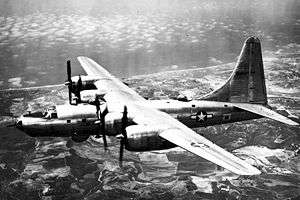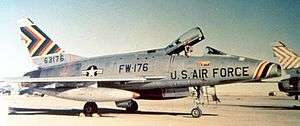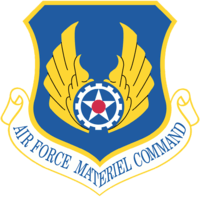312th Aeronautical Systems Group
| 312th Aeronautical Systems Wing | |
|---|---|
|
Emblem of the 312th Tactical Fighter Group | |
| Active | 28 January 1942 – present |
| Country | United States |
| Branch | Air Force |
| Type | Aeronautical Systems |
| Part of | Air Force Material Command |
| Garrison/HQ | Wright-Patterson Air Force Base |
| Engagements |
|
| Decorations |
|
The 312th Aeronautical Systems Group (312 ASG) is a component of the United States Air Force 312th Aeronautical Systems Wing. It is stationed at Wright-Patterson Air Force Base, Ohio and is assigned to Air Force Material Command (AFMC).
The unit's World War II predecessor unit, the 312th Bombardment Group, operated primarily in the Southwest Pacific Theater as an A-20 Havoc light bomber unit assigned to Fifth Air Force. The group also flew the B-32 Dominator on several evaluation combat missions at the end of the war. It was awarded both the United States Distinguished Unit Citation and the Philippine Presidential Unit Citation for its combat service in New Guinea; the Western Pacific; Leyte, and Luzon.
Overview
The 312th Aeronautical Systems Group has responsibility for program execution to develop, acquire, field and modernize capabilities; and support for life-cycle management of the Fighter Attack portfolio for the United States and coalition partners.
Unit responsibilities also include identifying, coordinating and implementing horizontal integration/capability planning across weapons systems in support of the Global Strike and Global Persistent Attack concept of operations.
History
- see: 312th Tactical Fighter Wing for additional lineage and history
World War II
The 312th Bombardment Group was activated on 15 March 1942 at Bowman Field (Fort Knox) Kentucky. It was redesignated 312th Bombardment Group (Dive) in July 1942 and trained in the United States for several months with A-3, A-31, A-36, and P-40 aircraft.
The unit was deployed to the Southwest Pacific, October–December 1943, and assigned to Fifth Air Force. It was again redesignated as the 312th Bombardment Group (Light) in December 1943. It began operations in New Guinea, flying patrol and escort missions. Following its conversion to the A-20 Havoc, the group attacked airfields, troop concentrations, gun positions, bridges, and warehouses on the northern and western coasts of New Guinea. It moved to the Philippines in November 1944 and provided support for ground troops and struck airfields and transportation facilities.
The 312th received a Distinguished Unit Citation for actions against Japanese butanol plants in Formosa, 25 March – 4 April 1945.

The 312th was selected to carry out field operation testing of the Consolidated B-32 Dominator in mid-1945 and made test flights over Luzon and Formosa in June 1945. The B-32 had been in development since before World War II, but a protracted development period delayed production versions of the aircraft until 1945. The first two B-32s arrived on Luzon on 2 May, with a third aircraft arriving the next day.
The first combat mission took place on 29 May 1945. It was a strike against a Japanese supply depot in Luzon's Cayagan Valley. All three of the Dominators were to take part, but one aborted on takeoff. The other two proceeded to the target. There was no enemy opposition, and bombing runs were made from an altitude of 10,000 feet, and both aircraft returned without incident. This raid was followed by a series of attacks on Japanese targets in the Philippines, in Formosa, and on Hainan Island in the Tonkin Gulf. The only opposition encountered during these missions was some rather inaccurate flak. The tests were thus deemed a success, and plans were made to convert the entire 386th Bombardment Squadron to B-32s. The 312th BG was scheduled to move to Okinawa as soon as the conversion of the 386th BS to the B-32 was completed.
Redesignated as the 312th Bombardment Group (Heavy) in July 1945, the unit moved to Okinawa in August 1945 and received six more aircraft. After the Atomic Bomb missions had been flown, Combat operations were flown with the B-32 in spite of the de facto cease-fire that had been called following the bombing of Nagasaki. During this time, the B-32s flew mainly photographic reconnaissance missions, most of which were unopposed. However, on 17 August a group of 4 B-32s flying over Tokyo were fired on by radar-directed flak and were attacked by Japanese fighters. The American aircraft escaped with only minor damage, claiming one confirmed fighter kill and two probables. During a reconnaissance mission over Tokyo on 18 August, two B-32s were attacked by Japanese fighters. The American gunners claimed two kills and one probable, but one aircraft was badly shot up and one of her crew was killed with two being injured. This was to prove to be the last combat action of World War II.
The last Dominator mission of the war was flown by four B-32s on 28 August in a reconnaissance mission to Tokyo. The mission was a disaster, although not because of any enemy action. 42-108544 lost an engine on takeoff and skidded off the runway. All 13 men aboard perished when the aircraft exploded and burned. On the way back from the target, 42-108528 lost power on two of its four engines. The plane's pilot ordered the crew to bail out, but two men were killed.
After VJ-Day, the surviving B-32 aircraft were ordered to return to the United States, ending the test program. The 312th remained on Okinawa until December until returning to the United States. It was inactivated on 6 January 1946.
Cold War

The 312th trained in the reserve from, 1947, being redesignated as the 312th Bombardment Group (Very Heavy), and equipped with B-29 Superfortresses. It was inactivated in 1949.
It was reactivated in 1954 and trained to maintain proficiency in fighter-bomber operations with conventional weapons to September 1955, then switched to training to maintain combat proficiency with atomic weapons. From April 1956 – October 1957, the wing rotated tactical squadrons to France, six months at a time. Inactivated when parent 312th Fighter-Bomber Wing adopted Tri-Deputate organization and assigned all flying squadrons directly to the Wing.
Lineage
- Established as 312th Bombardment Group (Light) on 28 January 1942
- Activated on 15 March 1942
- Redesignated: 312th Bombardment Group (Dive) on 27 July 1942
- Redesignated: 312th Bombardment Group (Light) on 21 December 1943
- Redesignated: 312th Bombardment Group, Light, on 14 February 1944
- Redesignated: 312th Bombardment Group, Heavy, on 19 July 1945
- Inactivated on 6 January 1946
- Redesignated 312th Bombardment Group, Very Heavy, on 14 July 1947
- Activated in the Reserves on 30 July 1947
- Inactivated on 27 June 1949
- Redesignated 312th Fighter-Bomber Group on 29 July 1954
- Activated on 1 October 1954
- Inactivated on 8 October 1957
- Redesignated 312th Tactical Fighter Group on 31 July 1985 (Remained inactive)
- Consolidated (23 June 2006) with the F-16 Systems Group, which was established on 23 November 2004
- Activated on 18 January 2005
- Redesignated 312th Aeronautical Systems Group on 14 July 2006.
Assignments
|
|
Components
- 386th Bombardment (later, 386th Fighter-Bomber) Squadron: 15 March 1942 – 18 December 1945; 13 August 1947-27 June 1949; 1 October 1954 – 8 October 1957
- 387th Bombardment (later, 387th Fighter-Bomber) Squadron: 15 March 1942 – 6 January 1946; 13 August 1947-27 June 1949; 1 October 1954 – 8 October 1957
- 388th Bombardment (later, 388th Fighter-Bomber) Squadron: 15 March 1942 – 4 January 1946; 13 August 1947-27 June 1949; 1 October 1954 – 8 October 1957
- 389th Bombardment Squadron: 15 March 1942 – 26 December 1945; 13 August 1947-27 June 1949.
Stations
|
|
Aircraft Assigned
|
|
See also
References
![]() This article incorporates public domain material from the Air Force Historical Research Agency website http://www.afhra.af.mil/.
This article incorporates public domain material from the Air Force Historical Research Agency website http://www.afhra.af.mil/.
- 312th Aeronautical Systems Group Factsheet
- Maurer, Maurer, ed. (1983) [1961]. Air Force Combat Units of World War II (PDF) (reprint ed.). Washington, DC: Office of Air Force History. ISBN 0-912799-02-1. LCCN 61060979.
- Maurer, Maurer, ed. (1982) [1969]. Combat Squadrons of the Air Force, World War II (PDF) (reprint ed.). Washington, DC: Office of Air Force History. ISBN 0-405-12194-6. LCCN 70605402. OCLC 72556.
- Ravenstein, Charles A. (1984). Air Force Combat Wings, Lineage & Honors Histories 1947-1977 (PDF). Washington, DC: Office of Air Force History. ISBN 0-912799-12-9.
- Wolf, William (2006). Consolidated B-32 Dominator: The Ultimate Look, from Drawing Board to Scrapyard. Schiffer Publishing. ISBN 0-7643-2451-9.
- B-32 Dominator Fact Sheet from the National Museum of the United States Air Force



.svg.png)

.svg.png)